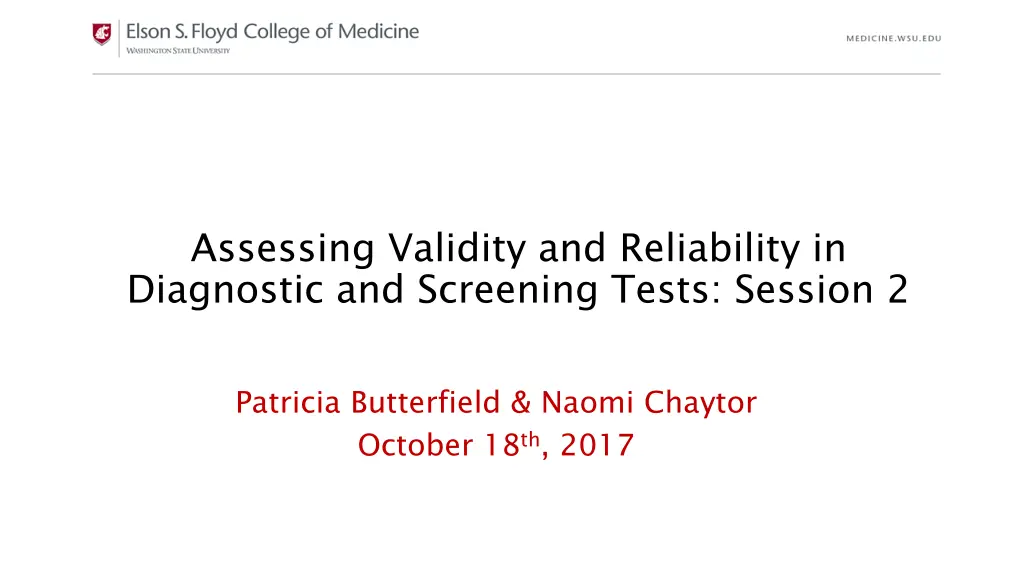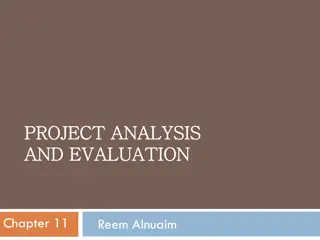
Understanding the Assessment of Validity and Reliability in Diagnostic Testing
Learn about assessing validity and reliability in diagnostic tests, including calculating sensitivity, specificity, positive predictive value, and negative predictive value. Explore case study examples and clinical vignettes to interpret these values and understand their clinical implications.
Download Presentation

Please find below an Image/Link to download the presentation.
The content on the website is provided AS IS for your information and personal use only. It may not be sold, licensed, or shared on other websites without obtaining consent from the author. If you encounter any issues during the download, it is possible that the publisher has removed the file from their server.
You are allowed to download the files provided on this website for personal or commercial use, subject to the condition that they are used lawfully. All files are the property of their respective owners.
The content on the website is provided AS IS for your information and personal use only. It may not be sold, licensed, or shared on other websites without obtaining consent from the author.
E N D
Presentation Transcript
Assessing Validity and Reliability in Diagnostic and Screening Tests: Session 2 Patricia Butterfield & Naomi Chaytor October 18th, 2017
Objective-hour 2: 4. Using case study examples and clinical vignettes, calculate and interpret sensitivity, specificity, positive predictive value, and negative predictive value.
1. Create a table from the data on facial weakness from table 5 in the paper 2. Calculate sensitivity and specificity
ANSWER 1: Focal Lesion 8 (True Pos) 38 (False Neg) 46 No Lesion 1 (False Pos) 18 (True Neg) 19 Abnormal Exam Normal Exam 9 56 65 Sensitivity: 8x100/46 = 17% Specificity: 18x100/19 = 95%
Calculate PPV and NPV: PPV = true positives x 100 true positives + false positives NPV = true negatives x 100 true negatives + false negatives Interpret these values Clinical implications?
ANSWER 2: Focal Lesion 8 (True Pos) 38 (False Neg) 46 No Lesion 1 (False Pos) 18 (True Neg) 19 Abnormal Exam Normal Exam 9 56 65 PPV = 8 (TP) x 100/9 (TP + FP) = 89% NPV = 18 (TN) x 100/56 (TN + FN) = 32% If you have a focal exam, you have an 89% likelihood of having a focal lesion If you have a normal exam, you have a 32% chance of not having a lesion (you are still more likely to have a lesion!)
What is the prevalence/Base Rate of focal lesions in the paper? Does this matter? What would happen if the prevalence of disease changed?
Half the groups (1% prevalence): Focal Lesion 5 25 30 No Lesion 149 2821 2970 Abnormal Exam Normal Exam 154 2846 3000 Half the groups (33% prevalence): Focal Lesion 5 25 30 No Lesion 3 57 60 Abnormal Exam Normal Exam 8 82 90
ANSWER 3: 1% prevalence of focal lesions: PPV = 5 (TP) x 100/154 (TP + FP) = 3% NPV = 2821 (TN) x 100/2846 (TN + FN) = 99% If you have a focal exam, you have a 3% chance of having a focal lesion (higher than 1%, but not much) If you have a normal exam, you have a 99% chance of not having a lesion (same as before test)
ANSWER 4: 33% prevalence of focal lesion: PPV = 5 (TP) x 100/8 (TP + FP) = 63% NPV = 57 (TN) x 100/82 (TN + FN) = 70% If you have a focal exam, you have a 63% chance of having a focal lesion (twice as good as base rate) If you have a normal exam, you have a 70% chance of not having a lesion (about the same as base rate)






















